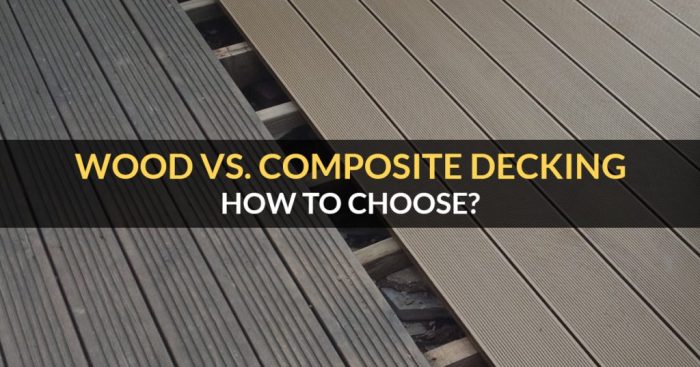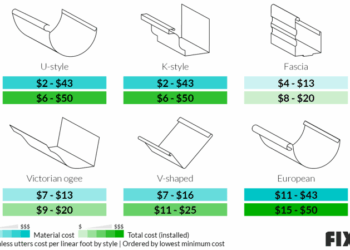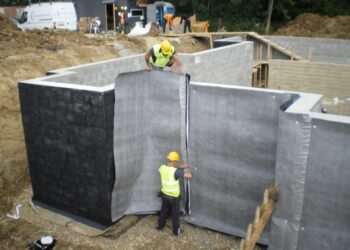Delving into the realm of decking materials, the contrast between composite and wood decking emerges as a pivotal decision for homeowners and builders alike. This article navigates through the nuances of each material, shedding light on the key factors that influence this crucial choice.
Introduction
When it comes to decking materials, two popular options are composite and wood. Composite decking is made from a combination of wood fibers and recycled plastic, offering a durable and low-maintenance alternative to traditional wood decking. On the other hand, wood decking is a classic choice with a natural look and feel.
Choosing the right decking material is crucial as it can impact the overall look, durability, maintenance, and cost of your deck. Factors such as budget, maintenance requirements, sustainability, and aesthetics play a significant role in deciding between composite and wood decking.
Key Factors to Consider
- Cost: Composite decking typically has a higher upfront cost but requires less maintenance over time, potentially leading to cost savings in the long run.
- Maintenance: Wood decking requires regular staining, sealing, and maintenance to prevent rot, decay, and insect damage, while composite decking is low-maintenance and only needs occasional cleaning.
- Durability: Composite decking is resistant to rot, mold, and insects, making it a durable option for outdoor use. Wood decking, while prone to wear and tear, can be more easily repaired or refinished.
- Aesthetics: Wood decking offers a natural and warm look that can enhance the beauty of outdoor spaces, while composite decking comes in a variety of colors and finishes to suit different design preferences.
- Sustainability: Composite decking is often made from recycled materials and is considered a more environmentally friendly option compared to traditional wood decking.
Material Composition
Composite decking is made up of a combination of wood fibers, plastic, and binding agents. The wood fibers can come from various sources, including sawdust, wood chips, or even recycled wood materials. The plastic component is usually a combination of polyethylene or polypropylene, which helps to provide durability and resistance to rot, decay, and insect damage.
The binding agents hold everything together and ensure a cohesive final product.Wood decking, on the other hand, is typically made from natural wood materials such as cedar, redwood, or pressure-treated pine. These materials are known for their natural beauty and classic appeal.
However, wood decking is susceptible to issues like rot, decay, and insect damage if not properly maintained and treated regularly.
Composite Decking
- Combination of wood fibers, plastic, and binding agents
- Wood fibers sourced from various sources
- Plastic component usually polyethylene or polypropylene
- Binding agents ensure a cohesive final product
Wood Decking
- Made from natural wood materials like cedar, redwood, or pressure-treated pine
- Natural beauty and classic appeal
- Susceptible to rot, decay, and insect damage without proper maintenance
Composite decking offers a more durable and low-maintenance option compared to traditional wood decking due to its composition of wood fibers, plastic, and binding agents.
Maintenance and Longevity
When it comes to the maintenance and longevity of decking materials, there are significant differences between composite and wood decking. Let's explore the key points to consider:
Maintenance Requirements of Composite Decking
Composite decking is known for its low maintenance requirements. Unlike wood decking, composite boards do not need to be stained, painted, or sealed regularly. To keep composite decking looking its best, a simple routine of cleaning with soap and water is usually sufficient.
Additionally, composite decking is resistant to rot, mold, and insect damage, reducing the need for extensive maintenance over time.
Differences in Maintenance between Wood and Composite Decking
Wood decking, on the other hand, requires more maintenance to preserve its appearance and structural integrity. Regular staining, painting, and sealing are necessary to protect wood from moisture damage, rot, and insect infestation. Without proper maintenance, wood decking can deteriorate faster and may require more frequent repairs or replacements compared to composite decking.
Longevity of Composite versus Wood Decking
In terms of longevity, composite decking generally outperforms wood decking, especially in various weather conditions. Composite boards are more durable and resistant to moisture, UV rays, and temperature fluctuations, which can cause wood to warp, crack, or fade over time.
As a result, composite decking often has a longer lifespan and retains its appearance for many years with minimal maintenance, making it a cost-effective and durable option for outdoor living spaces.
Aesthetics and Customization

When it comes to aesthetics and customization, both composite and wood decking offer unique options to enhance the look of outdoor spaces.
Aesthetic Options in Composite Decking
Composite decking comes in a wide range of colors, textures, and finishes, allowing homeowners to achieve the desired look for their outdoor living areas. From traditional wood-like grains to modern sleek designs, composite decking offers versatility in design options.
Natural Appeal and Customization of Wood Decking
Wood decking provides a natural and timeless appeal that many homeowners appreciate. The natural variations in wood grain and color allow for a unique and rustic look that cannot be replicated by composite materials. Additionally, wood decking can be stained or painted in various shades to suit individual preferences.
Design Flexibility of Composite and Wood Decking
While composite decking offers a wide variety of design options, wood decking provides the flexibility to be easily customized on-site. Wood can be cut, shaped, and stained to create intricate designs and patterns that may be harder to achieve with composite materials.
This design flexibility allows for more personalized and unique outdoor living spaces when using wood decking.
Environmental Impact
Composite decking and wood decking have different environmental impacts that should be considered when choosing between the two materials.
Composite Decking
Composite decking is often praised for being eco-friendly due to its use of recycled materials such as plastic and wood fibers. However, the manufacturing process of composite decking involves the use of chemicals and energy-intensive procedures, which can contribute to environmental pollution.
Additionally, composite decking is not biodegradable and can release harmful chemicals into the environment when disposed of improperly.
Wood Decking
Wood decking, when sourced from sustainable forests or managed plantations, can be a more sustainable option compared to composite decking. Wood is a renewable resource that can be biodegraded naturally, reducing the environmental impact of disposal. However, the logging and transportation of wood can contribute to deforestation and carbon emissions if not managed responsibly.
Comparison
When comparing the environmental impact of manufacturing, installing, and disposing of composite versus wood decking, it is essential to consider the entire lifecycle of the materials. While composite decking has the advantage of using recycled materials, the energy-intensive manufacturing process and non-biodegradable nature of the material can offset its eco-friendly benefits.
On the other hand, wood decking, if sourced sustainably, can have a lower carbon footprint and be more biodegradable. However, it is crucial to ensure that the wood is sourced from certified sustainable sources to minimize deforestation and environmental degradation.
Cost Analysis
When it comes to choosing between composite and wood decking, the cost implications play a significant role in decision-making. Let's break down the initial and long-term costs associated with both options.
Initial Cost of Composite Decking
Composite decking typically has a higher initial cost compared to wood decking. The materials used in composite decking, such as recycled plastics and wood fibers, are more expensive to produce. Additionally, the installation process for composite decking may require specialized tools and labor, increasing the upfront expenses.
Upfront Expenses for Wood Decking
Wood decking, on the other hand, tends to have a lower initial cost than composite decking. The materials used in wood decking, such as pressure-treated lumber, are generally more affordable. However, it is essential to consider the maintenance and repair costs that may arise over time due to factors like rot, warping, and insect damage.
Long-Term Cost Comparison
When comparing the long-term cost implications of choosing composite versus wood decking, it's essential to factor in maintenance and longevity. Composite decking requires minimal maintenance and is more durable than wood decking, which may require regular staining, sealing, and repairs.
Over time, the maintenance costs associated with wood decking can add up, potentially making composite decking a more cost-effective option in the long run.
Conclusive Thoughts
In conclusion, the battle between composite and wood decking unveils a myriad of considerations spanning from aesthetics to environmental impact. As you weigh your options, remember that the perfect decking material is not just about functionality but also about aligning with your values and preferences.
General Inquiries
Is composite decking more durable than wood decking?
Composite decking generally tends to be more durable than wood decking due to its resistance to rot, decay, and insect damage.
What maintenance differences exist between composite and wood decking?
Composite decking requires minimal maintenance, usually limited to occasional cleaning, while wood decking typically needs regular staining, sealing, and repairs.
Are there significant cost differences between composite and wood decking?
While composite decking may have a higher upfront cost, it often proves to be more cost-effective in the long run due to lower maintenance and longevity.











